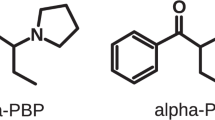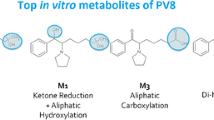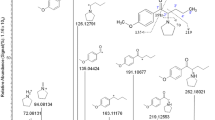Abstract
Human liver microsomes (HLMs) are used to simulate human xenobiotic metabolism in vitro. In forensic and clinical toxicology, HLMs are popularly used to study the metabolism of new designer drugs for example. In this work, we present an automated online extraction system we developed for HLM experiments, which was compared to a classical offline approach. Furthermore, we present studies on the metabolism of 11 cathinones; for eight of these, the metabolism has not previously been reported. Metabolites were identified based on MS2 and MS3 scans. Fifty-three substances encompassing various classes of drugs were employed to compare the established offline and the new online methods. The metabolism of each of the following 11 cathinones was studied using the new method: 3,4-methylenedioxy-N-benzylcathinone, benzedrone, butylone, dimethylcathinone, ethylone, flephedrone, methedrone, methylone, methylethylcathinone, naphyrone, and pentylone. The agreement between the offline and the online methods was good; a total of 158 metabolites were identified. Using only the offline method, 156 (98.7%) metabolites were identified, while 151 (95.6%) were identified using only the online method. The metabolic pathways identified for the 11 cathinones included the reduction of the keto group, desalkylation, hydroxylation, and desmethylenation in cathinones containing a methylenedioxy moiety. Our method provides a straightforward approach to identifying metabolites which can then be added to the library utilized by our clinical toxicological screening method. The performance of our method compares well with that of an established offline HLM procedure, but is as automated as possible.





Similar content being viewed by others
Abbreviations
- APCI:
-
Atmospheric pressure chemical ionization
- AU:
-
Arbitrary units
- bk:
-
Beta-keto
- CYP:
-
Cytochrome P450
- EDTA:
-
Ethylenediaminetetraacetic acid
- ESI:
-
Electrospray ionization
- GST:
-
Glutathione-S-transferase
- G6P:
-
Glucose-6-phosphate
- G6PD:
-
Glucose-6-phosphate dehydrogenase
- HPLC:
-
High-pressure liquid chromatography
- HLMs:
-
Human liver microsomes
- IU:
-
International units
- LC-MS:
-
Liquid chromatography–mass spectrometry
- MDPV:
-
Methylenedioxypyrovalerone
- NADP+ :
-
Nicotinic acid adenine dinucleotide phosphate (oxidized form)
- NADPH:
-
Nicotinic acid adenine dinucleotide phosphate (reduced form)
- NAT:
-
N-Acetyltransferase
References
Asha S, Vidyavathi M (2010) Role of human liver microsomes in in vitro metabolism of drugs—a review. Appl Biochem Biotechnol 160:1699–1722
Wintermeyer A, Moller I, Thevis M, Jubner M, Beike J, Rothschild MA, Bender K (2010) In vitro phase I metabolism of the synthetic cannabimimetic JWH-018. Anal Bioanal Chem 398:2141–2153
Meyer MR, Du P, Schuster F, Maurer HH (2010) Studies on the metabolism of the alpha-pyrrolidinophenone designer drug methylenedioxy-pyrovalerone (MDPV) in rat and human urine and human liver microsomes using GC-MS and LC-high-resolution MS and its detectability in urine by GC-MS. J Mass Spectrom 45:1426–1442
Zaitsu K, Katagi M, Kamata HT, Kamata T, Shima N, Miki A, Tsuchihashi H, Mori Y (2009) Determination of the metabolites of the new designer drugs bk-MBDB and bk-MDEA in human urine. Forensic Sci Int 188:131–139
Meyer MR, Maurer HH (2011) Current status of hyphenated mass spectrometry in studies of the metabolism of drugs of abuse, including doping agents. Anal Bioanal Chem
Drexler DM, Belcastro JV, Dickinson KE, Edinger KJ, Hnatyshyn SY, Josephs JL, Langish RA, McNaney CA, Santone KS, Shipkova PA, Tymiak AA, Zvyaga TA, Sanders M (2007) An automated high throughput liquid chromatography–mass spectrometry process to assess the metabolic stability of drug candidates. Assay Drug Dev Technol 5:247–264
Xu R, Manuel M, Cramlett J, Kassel DB (2010) A high throughput metabolic stability screening workflow with automated assessment of data quality in pharmaceutical industry. J Chromatogr A 1217:1616–1625
Jenkins KM, Angeles R, Quintos MT, Xu R, Kassel DB, Rourick RA (2004) Automated high throughput ADME assays for metabolic stability and cytochrome P450 inhibition profiling of combinatorial libraries. J Pharm Biomed Anal 34:989–1004
Lai F, Khojasteh-Bakht SC (2005) Automated online liquid chromatographic/mass spectrometric metabolic study for prodrug stability. J Chromatogr B 814:225–232
Kool J, van Liempd SM, van Rossum H, van Elswijk DA, Irth H, Commandeur JN, Vermeulen NP (2007) Development of three parallel cytochrome P450 enzyme affinity detection systems coupled on-line to gradient high-performance liquid chromatography. Drug Metab Dispos 35:640–648
Nicoli R, Curcio R, Rudaz S, Veuthey JL (2009) Development of an in-capillary approach to nanoscale automated in vitro cytochromes p450 assays. J Med Chem 52:2192–2195
Curcio R, Nicoli R, Rudaz S, Veuthey JL (2010) Evaluation of an in-capillary approach for performing quantitative cytochrome P450 activity studies. Anal Bioanal Chem 398:2163–2171
Mueller DM, Duretz B, Espourteille FA, Rentsch KM (2011) Development of a fully automated toxicological LC-MS(n) screening system in urine using online extraction with turbulent flow chromatography. Anal Bioanal Chem 400:89–100
Cozzi NV, Sievert MK, Shulgin AT, Jacob P 3rd, Ruoho AE (1999) Inhibition of plasma membrane monoamine transporters by beta-ketoamphetamines. Eur J Pharmacol 381:63–69
Mueller DM, Rentsch KM (2011) Online extraction toxicological MS(n) screening system for serum and heparinized plasma and comparison of screening results between plasma and urine in the context of clinical data. J Chromatogr B
Sohl CD, Cheng Q, Guengerich FP (2009) Chromatographic assays of drug oxidation by human cytochrome P450 3A4. Nat Protoc 4:1252–1257
Kamata HT, Shima N, Zaitsu K, Kamata T, Miki A, Nishikawa M, Katagi M, Tsuchihashi H (2006) Metabolism of the recently encountered designer drug, methylone, in humans and rats. Xenobiotica 36:709–723
Meyer MR, Wilhelm J, Peters FT, Maurer HH (2010) Beta-keto amphetamines: studies on the metabolism of the designer drug mephedrone and toxicological detection of mephedrone, butylone, and methylone in urine using gas chromatography–mass spectrometry. Anal Bioanal Chem 397:1225–1233
Acknowledgements
The authors would like to thank Thermo Fisher Scientific for providing the LC-MS system and the online extraction instrument.
Author information
Authors and Affiliations
Corresponding author
Rights and permissions
About this article
Cite this article
Mueller, D.M., Rentsch, K.M. Generation of metabolites by an automated online metabolism method using human liver microsomes with subsequent identification by LC-MS(n), and metabolism of 11 cathinones. Anal Bioanal Chem 402, 2141–2151 (2012). https://doi.org/10.1007/s00216-011-5678-8
Received:
Revised:
Accepted:
Published:
Issue Date:
DOI: https://doi.org/10.1007/s00216-011-5678-8




